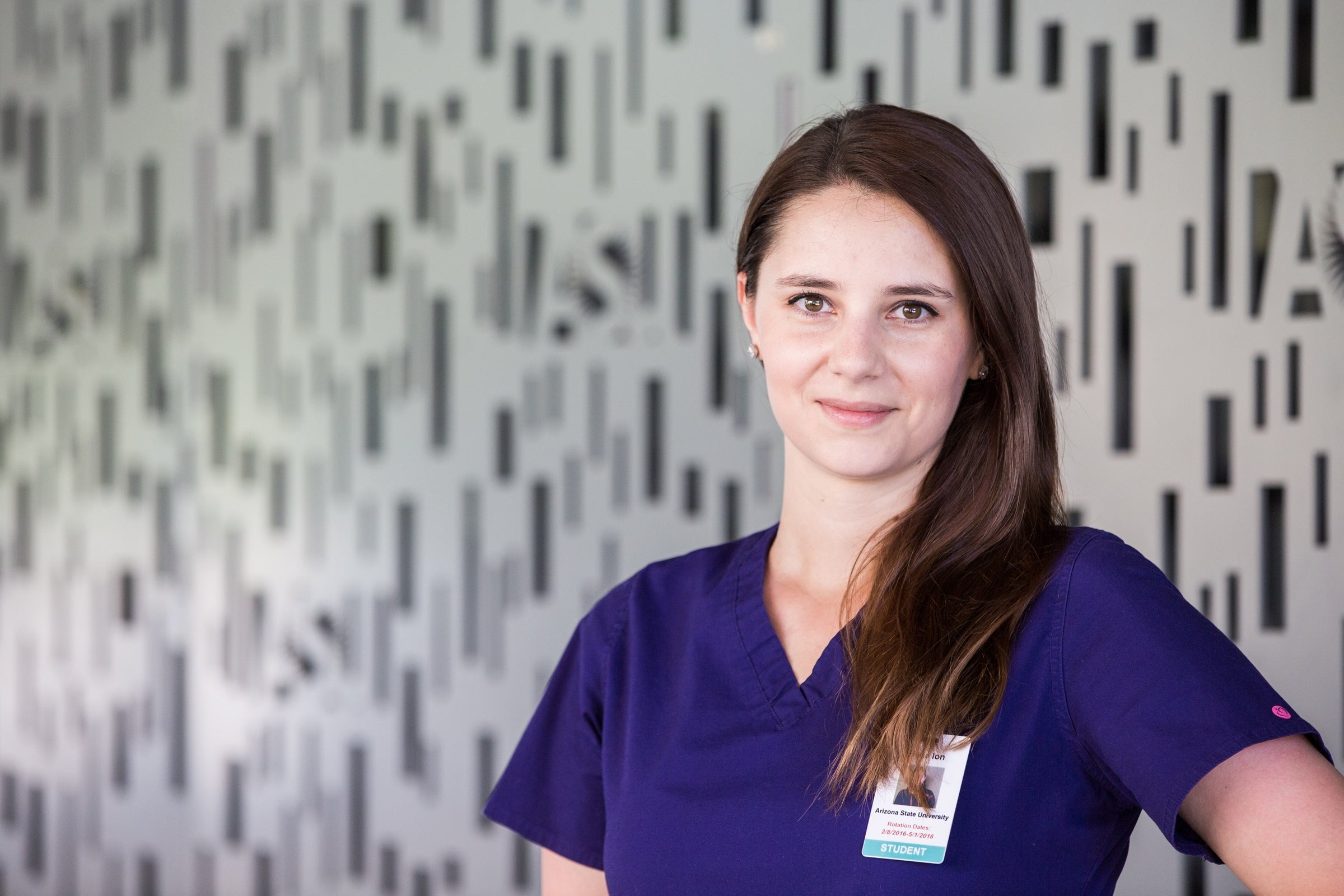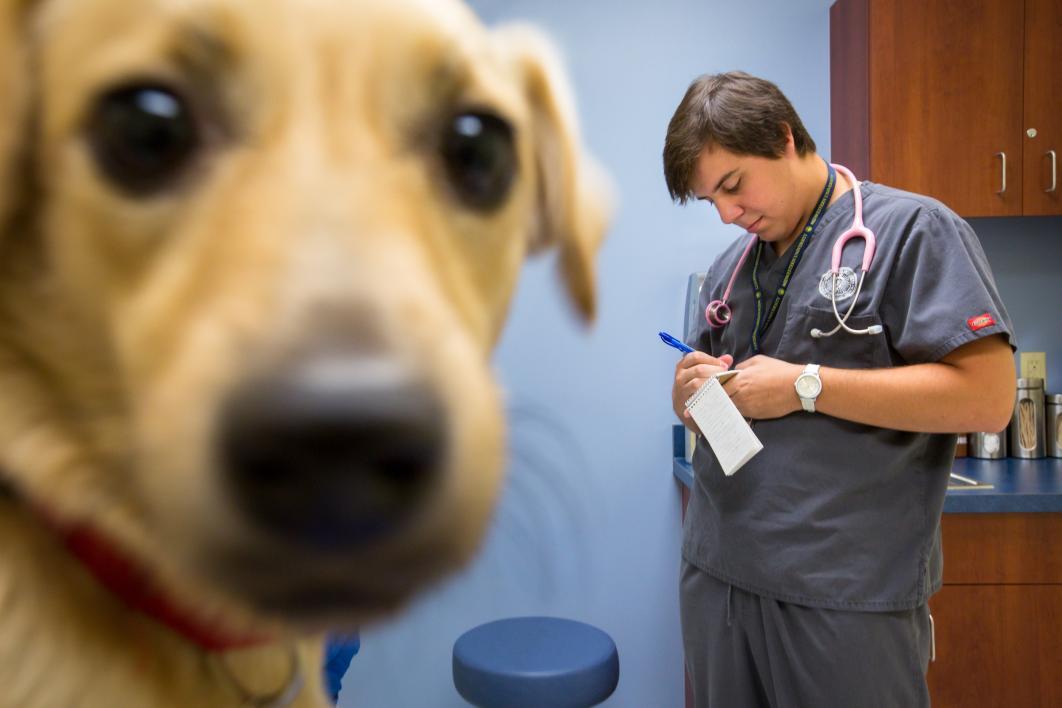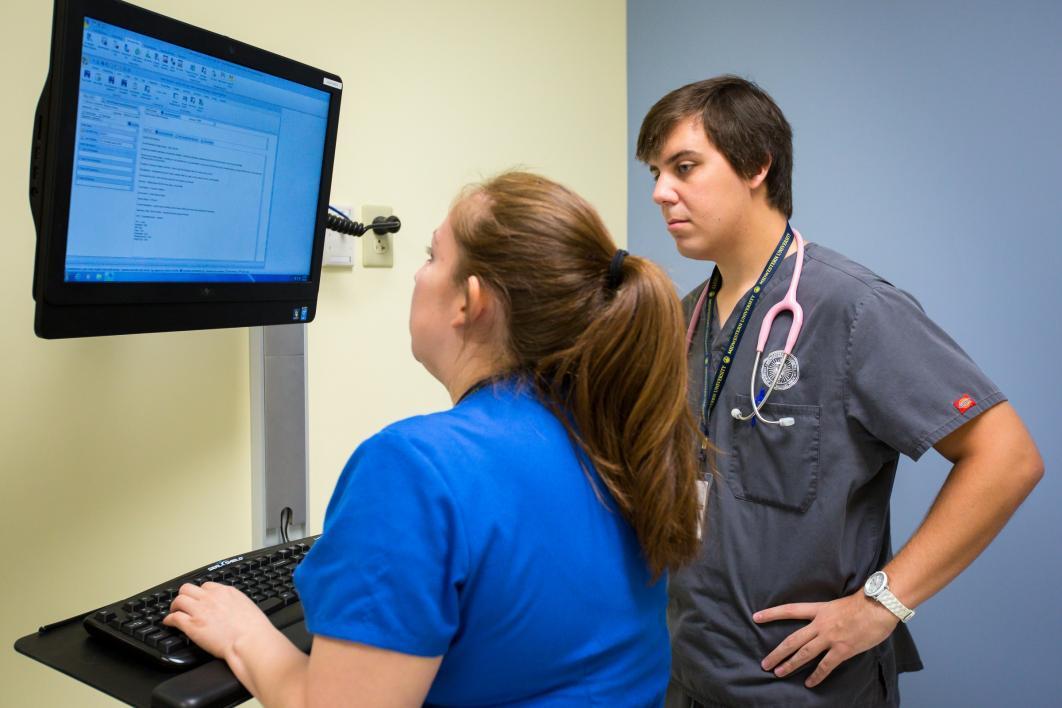Ever since Kenny Peterson (pictured above) was young, he’s wanted to be a vet — and it shows. He greets each pup at Midwestern Small Animal Clinic, where he’s interning, with a big smile and a gentle rub. The pre-health bio major genuinely loves the work he’s doing, and he’s getting to do it while he’s still an undergrad at Arizona State University.
In the past, students majoring in pre-health disciplines had to practically jump through hoops just to get a decent amount of hands-on medical experience during their undergrad years. Now, ASU’s Office of Clinical Partnerships’ Pre-Health Internship Program (PHIP) is providing a one-stop shop where they can apply for and be matched to internships that provide them with the relevant clinical hours they need to gain the experience and edge they need to go on to med school.
Pre-health majors come from a variety of schools and colleges within ASU, and this program is for all of them. Before it existed, there simply wasn’t a coordinated effort between all of the schools and colleges aimed at helping students get internship experience, said Renae Larcus, manager for health internships at ASU; they each had their own way of doing things.
So the task for Larcus and her colleagues was to identify how to provide a coordinated approach for students looking for clinical internships. “The intent was to create a one-stop shop where students could do the application process and be matched to a placement site that fit them,” she said.
There are three sessions available: spring, summer and fall. The program placed its first cohort of 19 students in the summer 2015 session, and that number grew to 40 for the summer 2016 session. For this fall’s session, they anticipate to place 125 pre-health students in clinical internships.
Elena Ion participated in the Pre-health Internship Program
Elena Ion participated in the program’s spring 2016 session and has since graduated from ASU with a bachelor’s in microbiology. She was placed at HonorHealth Scottsdale Shea Medical Center, where she shadowed doctors and nurses.
While she learned the basics, such as how to take a patients’ vitals and administer medications, she also learned some unexpected lessons. “We had this one child — poor kid — 11 years old, and he fell into a cactus,” she recalled. When removing the needles became too painful for him, the doctor made the decision to sedate the boy. Before that could be done, though, he had to explain to his parents why, how and what they were about to do.
“This internship gave me the opportunity to see how the doctors interact with patients, and how the nurses interact with patients,” Ion said. “I learned that you have to make sure that people understand what you’re doing. You can’t just walk in and tell them in scientific terms, ‘We’re going to do this,’ because if they don’t understand, they might get scared, and then you don’t have that trusting doctor-patient connection.”
Christina Islas is the program’s placement specialist, working with pre-health majors at all four ASU campuses. She serves as the liaison between the students and the placement sites, which she tours ahead of time to meet the staff and get a rundown of what the students will be doing on a daily basis.
“Having this opportunity opens a lot of doors for students,” Islas said. “Actually, getting to have these experiences first-hand, before medical school is an eye-opener. And the majority of placement sites are doctor’s offices and clinics, so they get to understand the business part of it, too.”
Before his internship at the animal clinic, Peterson thought being a veterinarian would be somewhat laid back. “In all actuality, it’s a pretty non-stop industry,” he said. “If you have one client in a room, you might be finishing up paperwork on the client you were just with, and you have another person coming to you with another client that’s ready to see you. So I’ve just been learning a lot of good techniques on how to handle stress, how to handle difficult situations and still be professional.”
Aside from the clinical hours, the internship also has a class portion in which students learn invaluable information, like how to apply for med school.
“You sit down and they go through the application with you, and they give you advice about how you should write your personal statement,” Ion said. “It’s a lot of useful information that nobody tells you. … Small details that you probably would find out eventually but maybe the hard way.”
Ion just recently finished her application for med school and is set to take the MCAT Aug. 5. She’s got her sights set on becoming a general surgeon and has her fingers crossed that she’ll get accepted to the Mayo Medical School opening in Scottsdale in 2017.
“I feel like now I have a better understanding of what to expect,” she said.
As for Peterson, he completed his internship July 8 but still has two more semesters before graduating from ASU with his bachelor’s in biology. When he does, though, he’ll have plenty of clinical experience.
“It’s definitely very competitive and difficult to get into the medical field,” he said. “So having an internship like this — whether it’s at Midwestern, or a private practice, or something else — at least you’re getting that experience. And after this semester, I will have 135 hours of clinical experience that I can add to my resume.”
Larcus is grateful that the program is meeting ASU pre-health students’ needs and helping to ensure their success.
“Everybody’s got a 4.0. Everybody’s got good MACT scores,” she said. “[Students] are trying to beef up their resume, and what they’ve found is that because they lack clinical hours, it puts them at a disadvantage. This program is providing them with a good opportunity to get clinical hours that will increase their chances of getting into medical school.”
More Health and medicine
College of Health Solutions program doing its part during Salute to Service
It wasn’t always easy for Marine veteran Chuck Hale when he first returned to civilian life. But he’ll never forget the help he received from a fellow former service member.“The first vet that helped…

What makes human culture unique?
Why is human culture — the shared body of knowledge passed down across generations — so much more powerful than animal cultures?“What’s special about our species?” is a question scientists have…

ASU honors students work on HPV research as part of Barrett College's largest-ever group thesis
Not every undergraduate student comes across the opportunity to do research as part of a team. Even fewer have had the chance to join a team of 86 students doing multidisciplinary research with real-…




